GB Pocket Card
GB Pocket Cards are tiny Menko-esque chips used as collectibles and as minigames, dispensed at random by gashapon machines (think gumball machines but for toys/etc). They can be though of as the equivalent of Carddass and Sealdass, but for gashapon. Starting in 1997, multiple sets would be released by the company Kyodo Co., Ltd. until at least 2007 (these sets generally include matte and holo versions of each chip). Also released were plastic containers shaped like Gameboys (and later Nintendo 64s and Gameboy Advances) that could hold a set, displaying the top chip on the screen.
|
(Example from the GB Pocket Card: Anime Best Scene Collection set, detailing how to open the GB Pocket holder and insert the card set for safekeeping.)
|

(courtesy of divajoanne) |
But how are these used as minigames? Well, each set could be used in a battle-style game; these games were distinct to each set and were not intended to be combined in any way. While the specifics depend on which set, the general gist was 2 players would align up their chips and compare how the backs line up. Some might have combative symbols or arrows, others might have more wordy impacts.
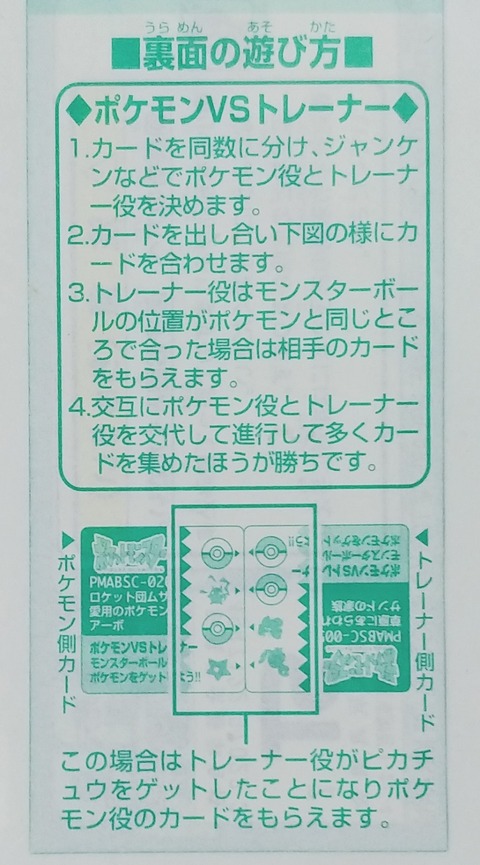
(courtesy of divajoanne) |
(Example from the GB Pocket Card: Anime Best Scene Collection set)
1. Divide cards into two decks of equal number, one for each player. Play a game of Rock, Paper, Scissors. The winner plays the Trainer first, the loser plays the Pokemon first. 2. Each player takes the top card of their deck and aligns them as shown here. 3. If a Pokeball on the Trainer player's card aligns with a Pokemon symbol on the Pokemon player's card, the Trainer player takes the Pokemon player's card. 4. The players switch Trainer and Pokemon roles with each other and a new turn begins. The player with the most cards collected wins. In the example given here, the Trainer player would gain the card. |
Here is an incomplete listing of known sets:
|
Pocket Monsters: Bros Card (Base Set) |
1997 |
How to Play:
Each player compares the arrows on the back of their card. Winner collects the loser's card. The player with the most cards collected wins. |
Standard
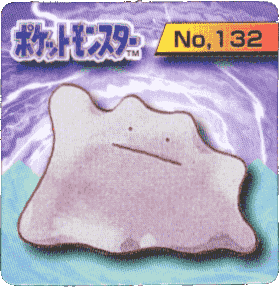
|

|
Holographic

|

|
|||
|
|
||||
|
GB Pocket Card: Anime Collection |
1997 |
How to Play:
Align your cards, arrows on the back facing each other. Compare the points in the Pokeballs. Winner collects the loser's card. The player with the most cards collected wins. |
Standard
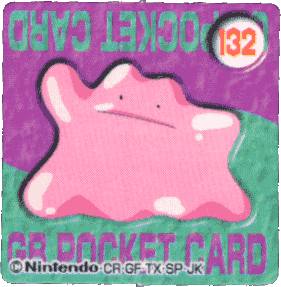
|
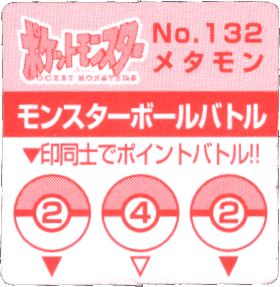
|
|
|
||||
|
GB Pocket Card: Final Collection (Base Set) |
1997 |
How to Play:
Each player compares the Confrontation Point on the back of their card. The winning card's effect takes precedent. Winner collects the loser's card. The player with the most cards collected wins. |
Holographic
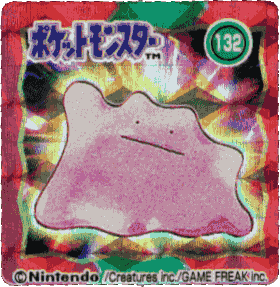
|
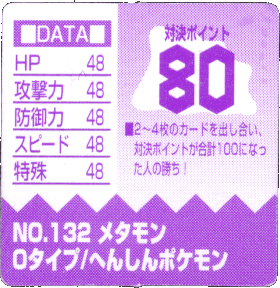
|
|
|
||||
|
GB Pocket Card: Anime Best Scene Collection |
1998 |
How to Play:
Each player alternates Trainer/Pokemon roles. Align the back of the cards to see if the Trainer catches a Pokemon (The player collects the loser's card). The player with the most cards collected wins. |
||
|
|
||||
|
N64 Card: Pokémon Stadium Collection |
August 1998 |
This is for the Japan-only Pokémon Stadium game. Play seems to be based around comparing the +/- type match-up numbers on the back. |
Standard

|

|
Holographic

|
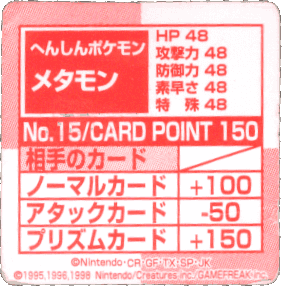
|
|||
|
|
||||
|
N64 Card: Pokémon Stadium Collection 2 |
1999 |
This is for the game Pokémon Stadium (known as Pokémon Stadium 2 in Japan). Like the first set, play seems to be based around comparing the +/- type match-up numbers on the back. |
||
|
|
||||
|
GB Pocket Card: GBP Card Collection 2 |
1999 | |||
|
|
||||
|
N64 Card: Pokémon Stadium 2 Collection |
2000 |
This is for the game Pokémon Stadium 2 (known as Pokémon Stadium Gold and Silver in Japan). Like the other two stadium sets, play seems to be based around comparing the +/- type match-up numbers on the back. |
||
|
|
||||
|
GBA Card: Ruby and Sapphire Collection |
2004(?) |
Standard

|

|
|
|
|
||||
|
GBA Card: Diamond and Pearl Collection |
2007 | |||